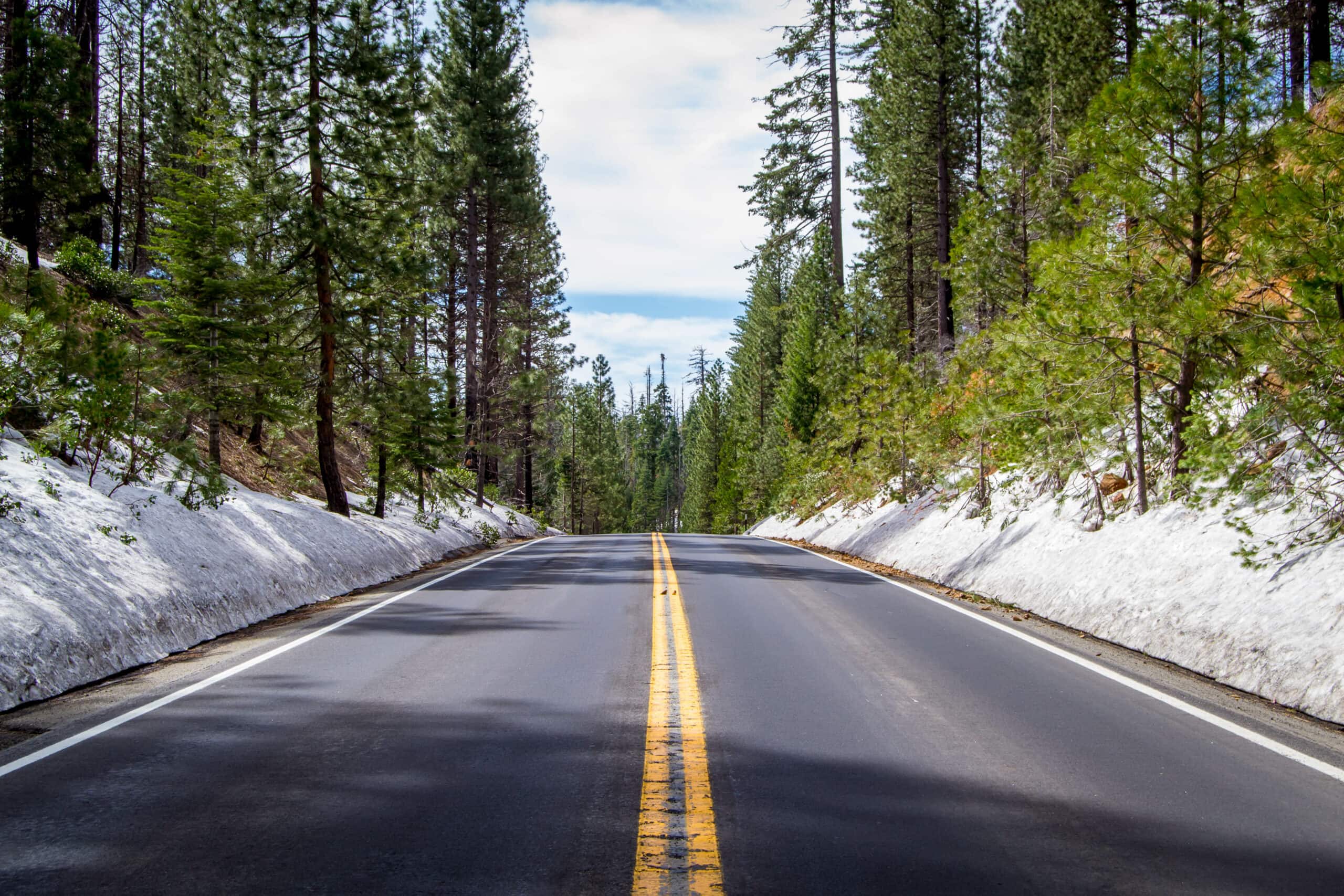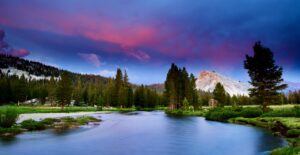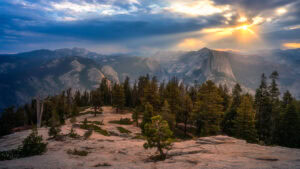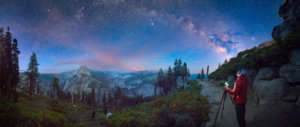Visiting Yosemite in Winter
If you have never visited Yosemite in the winter season then you are missing out on one of the most beautiful times to see the park. When visiting Yosemite in winter, the conditions are mild during most days with cool temps and sunshine, aside from when the occasional rain or snowstorm comes in and covers the landscape with a sparkly blanket of powder.
Driving to Yosemite in Winter
Yosemite Valley roads normally remain open, making driving to Yosemite in winter relatively easy to view Yosemite’s major icons, like Half Dome, El Capitan and Yosemite Falls. However snow fun is close at hand. Enjoy world-class snowshoeing and cross country skiing at Badger Pass Ski Area. Or plan to ride the lifts for family-friendly downhill skiing, and snowboarding. The little ones love snow tubing at Badger Pass too, when there is enough snow to build the course. Badger Pass has been known for decades as the “most family (and wallet) friendly, learn to ski/snowboard area in California”!
Still, winter in the mountains makes its own kind of adventure. Be prepared for cold or icy conditions should they arise. Make sure you know what to expect with these top tips for visiting Yosemite in winter.
Lower elevations of Mariposa County remain comfortably warm during winter, with the hillsides and mountains becoming verdant green with each passing storm.
What to Pack When Visiting Yosemite in Winter
The key to preparing for a trip that could be 50°F (10°C) and sunny or 20°F (-7°C) and snowing is to be flexible. That includes the clothes that you bring.
Bring plenty of different layers with you. If you’re visiting Yosemite in winter, pack a warm hat, and gloves or mittens. Make those waterproof if you’re the kind of person who can’t resist a good snowball fight.
For your upper body, this usually means
- a base layer (thermal or long-sleeved shirt)
- mid-layer (flannel or fleece)
- insulated coat or jacket
- waterproof jacket
Denim or cotton clothing absorbs water and stays wet. If you’re interested in snow play, you might also want some kind of waterproof pant. However, if you’re planning on snowshoeing, skiing or snowboarding, remember that you’re going to be relatively active. Thick snow pants might be overkill unless it is particularly chilly or you get cold easily.
Don’t forget your feet! Your feet are arguably the most important aspect of a walk around Yosemite in winter. If your feet get cold or wet, you won’t feel like walking far. Shoes or boots that are waterproof, or water-resistant go a long way – both literally and figuratively. If you don’t have waterproof boots, you can wear plastic bags inside your shoes, and over your socks as a vapor barrier liner. Because the plastic doesn’t breathe, your feet may get sweaty this way, but they will stay warmer. Regardless, you can’t go wrong with a few extra pair of warm socks, preferably wool or synthetic.
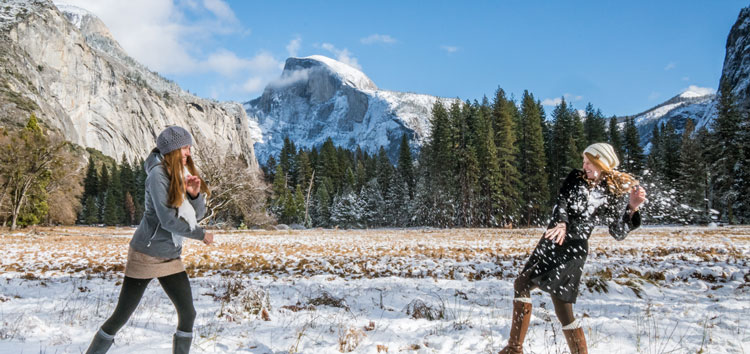
Extra winter gear
Mostly, you’ll probably pack what you’d expect for a trip. However, here are a few things for visiting Yosemite in winter that sometimes people don’t think of:
- Headlamp – There is very little ambient street lighting in Yosemite, so once the sun sets it gets really dark. This is wonderful for watching the stars, but can be complicated for moving around. Of course, most phones now have an adequate light, but when it’s chilly out, it’s nice to be able to wear the light on your head and put your hands in your pockets to keep them warm.
- Refillable water bottle – Don’t waste your money on plastic water bottles. Yosemite has some of the cleanest, sweetest tasting water in the world. There are several water filling stations in Yosemite Valley and Badger Pass so it’s easy to refill. If you don’t have a refillable water bottle, you can pick one up at a local gift shop. They make excellent souvenirs.
- Sunglasses, Sunscreen & Lip Balm – Yosemite gets a lot of sun, even in the winter. At elevation, that sun is more powerful than it is at sea level so your risk of burning is higher than you might expect. Plus, if you do head up to the snow, the light bounces off the snow. That makes it extra bright and makes it possible to burn places like the underside of your nose as well.
- Soft–sided cooler – A food cooler is handy for bringing food into Yosemite or buying supplies in the park, and soft-sided coolers pack down relatively small when not in use. But be bear aware – never leave scented items in your car no matter how small or sealed you think it is. Not all bears hibernate in the winter so you need to take the same precautions as in summer.
Check the Current Conditions Right Before Visiting
Weather Forecasts
Because the weather can be so variable in winter, your best bet is to check the conditions right before driving to Yosemite in winter. Average temperatures and precipitation can give you a general sense of what it might be like for your visit, but when making the decision whether to pack the warm jacket or the really warm jacket, you just need a good short-term forecast.
The conditions change substantially based on elevation as well. A gentle rain at 3000 feet (~900 M) can be a snowstorm at 6000 feet (~1800 M). The National Park Service has created a list of links to forecasts by location to help with this. (Note: Tioga Road is closed in the winter, so the location forecasts in the high country may be accurate, but you’ll have to ski there to find out.)
Another great resource for current conditions are the Yosemite webcams. Pop in and take a look at the current view of various locations with Yosemite.
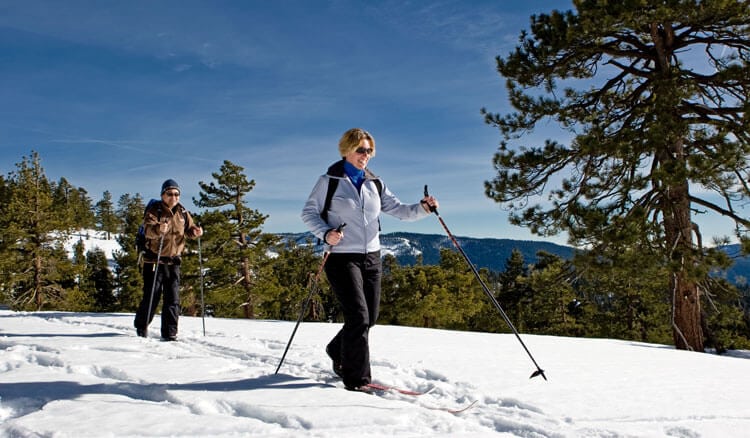
Current Road Conditions
Speaking of current Yosemite driving conditions, the best way to find out about up-to-date road conditions within Yosemite is to call the Yosemite – National Park Service Road conditions number at:
209-372-0200. Press 1 and 1 again.
This number is critical for finding out whether or not you will need to install snow chains on your vehicle in order to get where you are going. When conditions are changing quickly – like during a snowstorm – check this number frequently. It’s the best resource we have, and most Yosemite locals quickly develop the habit of calling that number before getting into their cars.
Snow chains or cables provide extra traction on slippery roads that might have a layer of snow or ice on them. So, chains can become required on any road if the conditions call for them. Once chain controls go into effect, you are required by the National Park Service to have them in your car, even if your car has snow tires and or four-wheel drive. The National Park Service strongly recommends that you carry chains if you’re visiting Yosemite in winter between November and March, though sometimes chain controls are in place as early as September or as late as May. Keep your eyes open for chain control signs along the road letting you know that you are entering a chain control area and also what level of chain control is required. Especially prior to incoming storms, park rangers are often out checking for chains and tire tread depth on vehicles.
Tire chains and cable traction devises are available for rent, or purchase in gateway towns such as Mariposa.
Not all chain control areas are created equal

Chain control signs come in three parts. The top part says, “Chains Required” and indicates that you are entering a designated chain control area. The second part reminds you that the speed limit within chain control areas is 25 mph, REGARDLESS of the posted speed limit. The bottom part tells you what the exceptions are.
Remember, even if your vehicle is exempted, you still have to carry the chains in your vehicle.
Read more about Chain Controls in Yosemite National Park, to learn what those exemptions are, get some tips on where to get them and how to install them.
Drive Safely – not too fast, but also not too slow
Whether or not you have chains on your vehicle, the speed limit within chain control areas is always 25 mph, regardless of the posted speed limit. Please understand this is for everyone’s safety. Driving too fast on slick and icy roads makes stopping and turning difficult. At the same time, the banked turns can be problematic if you’re driving too slowly. If you come to a stop on the high side of a banked corner, you risk sliding downhill into oncoming traffic or off the roadway.
Even more critical is the amount of space that you leave between you and the car in front of you. Anticipate longer stopping distances than you are used to, and give the driver in front of you a lot of extra room.
Don’t Want to Deal with Yosemite’s Winter Driving and Chains?
If you’re driving to Yosemite along the Highway 140 corridor, there is another option.
Park your car at a bus stop on Highway 140 and take the bus into Yosemite Valley. YARTS stops include Yosemite View Lodge, Cedar Lodge, Yosemite Bug Rustic Mountain Resort, Autocamp, and several choices in the town of Mariposa.
Once in Yosemite Valley, a free shuttle allows you to get to your favorite valley destinations. Another free shuttle runs between Yosemite Valley and Badger Pass Ski Area. (Note: YARTS routes along Hwy 120 and Hwy 41 are seasonal, and only available during the warmer months.)
Have you been to Yosemite in winter? Stop by Facebook, Twitter and Instagram at @YosemiteNation and share your own tips. Or ask a question – we’re happy to share what we know.

